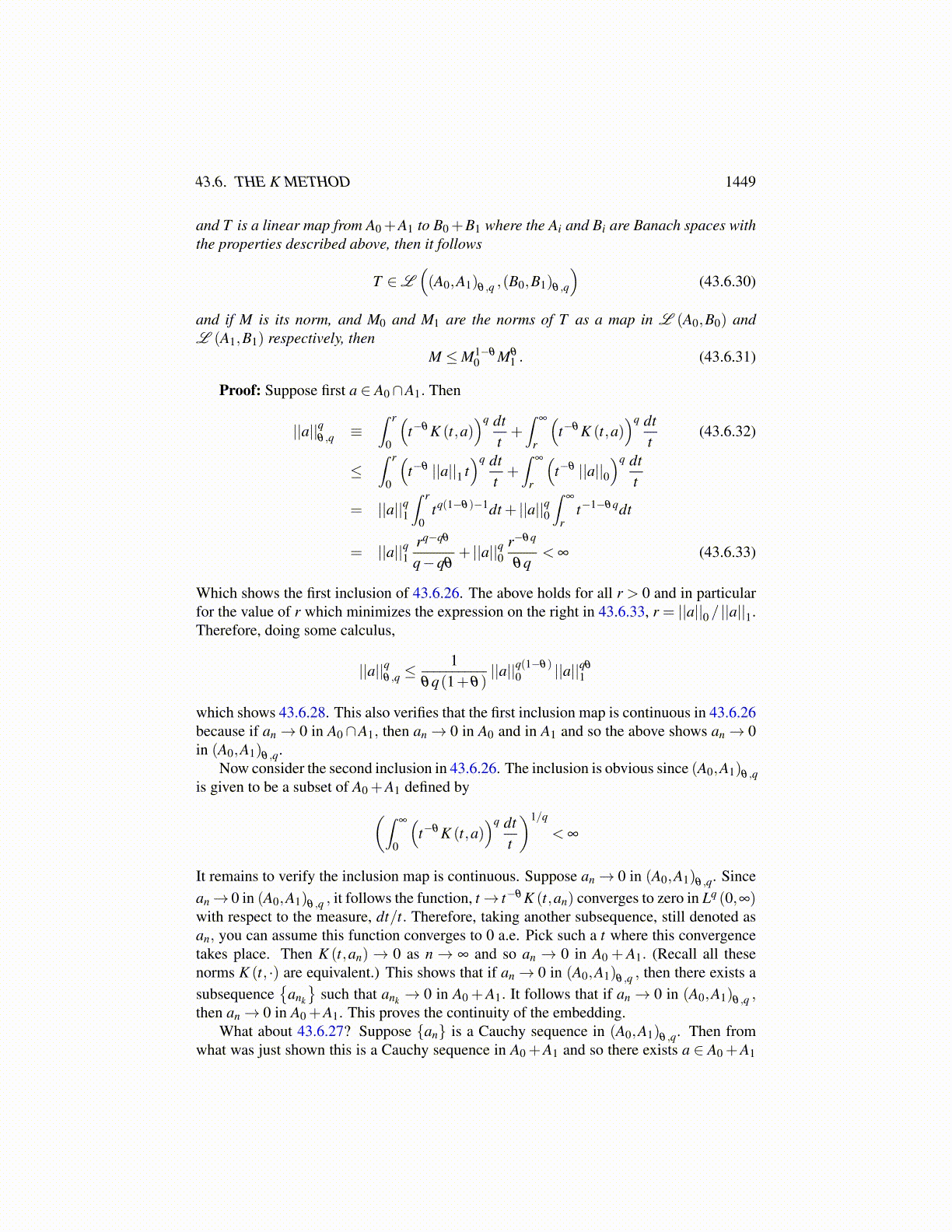
43.6. THE K METHOD 1449
Lemma 43.6.2 (A0 +A1,K (t, ·)) is a Banach space and all the norms, K (t, ·) are equiva-lent.
Proof: First, why is K (t, ·) a norm? It is clear that K (t,a) ≥ 0 and that if a = 0 thenK (t,a) = 0. Is this the only way this can happen? Suppose K (t,a) = 0. Then there exista0n ∈ A0 and a1n ∈ A1 such that ||a0n||0 → 0, ||a1n||1 → 0, and a = a0n + a1n. Since theembedding of Ai into X is continuous and since X is a topological vector space1, it follows
a = a0n +a1n→ 0
and so a = 0.Let α be a nonzero scalar. Then
K (t,αa) = inf{||a0||0 + t ||a1||1 : a0 +a1 = αa}
= inf{|α|∣∣∣∣∣∣a0
α
∣∣∣∣∣∣0+ t |α|
∣∣∣∣∣∣a1
α
∣∣∣∣∣∣1
:a0
α+
a1
α= a}
= |α| inf{∣∣∣∣∣∣a0
α
∣∣∣∣∣∣0+ t∣∣∣∣∣∣a1
α
∣∣∣∣∣∣1
:a0
α+
a1
α= a}
= |α| inf{||a0||0 + t ||a1||1 : a0 +a1 = a}= |α|K (t,a) .
It remains to verify the triangle inequality. Let ε > 0 be given. Then there exista0,a1,b0, and b1 in A0,A1,A0, and A1 respectively such that a0 +a1 = a,b0 +b1 = b and
ε +K (t,a)+K (t,b) > ||a0||0 + t ||a1||1 + ||b0||0 + t ||b1||1≥ ||a0 +b0||0 + t ||b1 +a1||1 ≥ K (t,a+b) .
This has shown that K (t, ·) is at least a norm. Are all these norms equivalent? If0 < s < t then it is clear that K (t,a)≥ K (s,a) . To show there exists a constant, C such thatCK (s,a)≥ K (t,a) for all a,
ts
K (s,a) ≡ ts
inf{||a0||0 + s ||a1||1 : a0 +a1 = a}
= inf{ t
s||a0||0 + s
ts||a1||1 : a0 +a1 = a
}= inf
{ ts||a0||0 + t ||a1||1 : a0 +a1 = a
}≥ inf{||a0||0 + t ||a1||1 : a0 +a1 = a}= K (t,a) .
Therefore, the two norms are equivalent as hoped.Finally, it is required to verify that (A0 +A1,K (t, ·)) is a Banach space. Since all these
norms are equivalent, it suffices to only consider the norm, K (1, ·). Let {a0n +a1n}∞
n=1 bea Cauchy sequence in A0 +A1. Then for m,n large enough,
K (1,a0n +a1n− (a0m +a1m))< ε.
1Vector addition is continuous is the property which is used here.